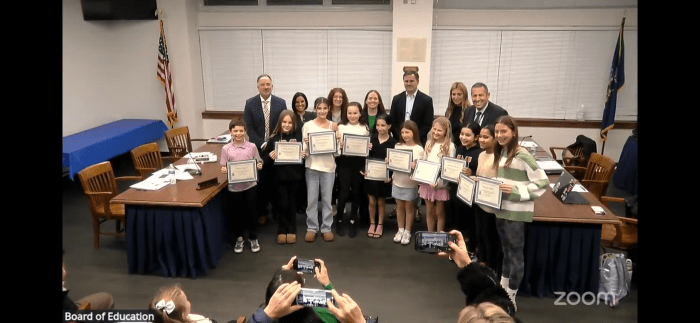The 2023 school year marked the first time the New York state government fully funded Foundation Aid, finally fulfilling the promise they made to students and parents 17 years ago. And then, in the very next budget season, they cut it back — and Long Island school districts are suffering for it.
As a result of the Campaign for Fiscal Equity v The State of New York lawsuit and the subsequent Education and Budget Reform Act of 2007, the state made a promise to increase funding for its schools. That funding is called Foundation Aid. How much each district got was determined by a complicated formula. One element of that formula, called the inflationary index, had been based on the one-year change to Consumer Price Index (CPI). This year, the Foundation Aid inflationary index was supposed to be 4.1 percent.
Hochul and the state legislature cut that number down to 2.4 percent.

“Governor Hochul has made record investments in education, including fully funding the Foundation Aid formula for the first time ever and increasing school aid for Long Island school districts by more than $1.4 billion since taking office,” said a spokesperson for Hochul’s office in a statement to the Press.
But every single school district on Long Island got less money than they were entitled to under the original terms of the settlement. The additional money they did receive was mostly from the money they had already been owed from previous years of the state not fully funding Foundation Aid, said Robert Vecchio, executive director of the Nassau Suffolk School Board Association, or NSSBA.
“She is saying that because there’s been an enrollment drop, we’re paying for empty classroom seats, and that couldn’t be further from the truth,” said Vecchio, who was also on the William Floyd school board for 18 years. “Even if schools have less students, the needs and demands on the students are greater. Mandates that were passed at the state level over the last 17 years (since) the formula was first created have changed and increased the cost of education.”
“Security issues, changing technology, the computer testing we have to do, all of these are additional costs that weren’t necessarily something we had to deal with 10 years ago,” said Jeanne D’Esposito, treasurer and secretary of NSSBA. “The costs go up, the things we have to pay for just keep increasing.”
The sweeping generalization of the Foundation Aid formula may work for areas of the state where cost of living is low, but that certainly is not Long Island. The problem is exacerbated by regional cost differences. And every dollar that is not sent to Long Island in state aid, Vecchio said, is then picked up by property tax owners. The island pays around 70 percent of property taxes on education, compared to around 48 percent by the rest of the state.
In some cases, the change in the formula was revealed only after a district’s budget had already been drafted, leaving them scrambling.

The Malverne school district, for example, lost out on an additional $200,000 or so in Foundation Aid funding that they had to find elsewhere. They had to tap into their reserves, which, though the district is rather fiscally conservative, are limited to begin with. In the 2025 fiscal year budget, Hochul said that a state reserve of 15 percent of the budget is the “gold standard” — but she limits school districts’ budgets to only 4 percent. Malverne was able to maneuver their budget to not cut any programs — but not every district is that lucky.
When costs like health insurance went up by double digits, districts need to find new places to make up for that loss in expected state funding. West Hempstead, for example, was forced to field cuts to Foundation Aid even while their transportation costs rose by $1.2 million. They had to excess eight teaching positions, slash professional development by 50 percent, and dip deeply into their budget in a way that is “not sustainable for the long run,” district officials said — but they had little other choice.
In many cases across the island, districts were forced to cut “non-essential” programs that students rely on.
“So you start being limited on some of the things that aren’t considered necessarily essential, and yet they are very much an important part of our kids’ education,” said D’Esposito, who is on the Malverne school board. “The opportunities that we give them beyond the core main subjects are things that often help produce well-rounded, successful graduates.”
The NSSBA represents 111 school districts across the island. Some had to eliminate teaching positions, D’Esposito said. Others cut Advanced Placement classes, or programs like sports, theatre, music, engineering or robotics.
“There’s nothing worse than not being able to give your child something they need that’s very, very important to them,” D’Esposito said. “There’s going to be a lot more pain if this keeps going in this direction. We’re very frightened.”
And the outlook for the coming school years is grim. Save Harmless is a provision that states districts cannot receive less in funding than they had the year prior. Hochul tried to eliminate that provision for the 2024-2025 school year, which would have taken away $43 million from Long Island schools, Vecchio said. He believes it’s a sign of what she’ll attempt again this year.
The Rockefeller Institute is conducting a study to see if and how the Foundation Aid formula should change and will release their findings on Dec. 1, but these are only recommendations that the governor’s office can ultimately ignore.
“Whatever changes to the formula happen, it’s going to impact schools across Long Island … for several years to come,” Vecchio said.
“It’s what’s keeping school board members, officials and superintendents up at night. Because we don’t know what’s coming.”
In the beginning of January, Hochul will reveal her upcoming plans for Foundation Aid. In the meantime, the best thing people can do, Vecchio said, is to contact their representatives and reiterate just how much Long Island needs Foundation Aid.




































